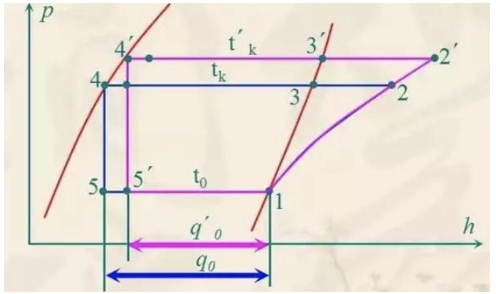- 10
- Oct
How to determine the evaporation temperature and condensation temperature? How to debug?
How to determine the evaporation temperature and condensation temperature? How to debug?
1. Condensing temperature:
The condensation temperature of the compressor system refers to the temperature at which the refrigerant condenses in the condenser, and the refrigerant vapor pressure corresponding to this temperature is the condensation pressure. For water-cooled condensers, the condensing temperature is generally 3-5°C higher than the cooling water temperature.

Kondenzačná teplota je jedným z hlavných prevádzkových parametrov chladiaceho cyklu. Pokiaľ ide o skutočné chladiace zariadenie, vzhľadom na malý rozsah variácií iných konštrukčných parametrov možno kondenzačnú teplotu považovať za najdôležitejší prevádzkový parameter, ktorý priamo súvisí s chladiacim účinkom, bezpečnosťou a spoľahlivosťou chladiaceho zariadenia a spotrebou energie. úrovne.
2. Teplota odparovania:
Teplota odparovania sa týka teploty, pri ktorej sa chladivo odparí a vrie vo výparníku. Zodpovedá zodpovedajúcemu odparovaciemu tlaku. Teplota odparovania je tiež dôležitým parametrom v chladiacom systéme. Teplota odparovania je spravidla o 2 až 3 ° C nižšia ako požadovaná teplota vody.
Teplota odparovania je teplota chladenia za ideálnych podmienok, ale teplota odparovania chladiva v skutočnej prevádzke je o 3 až 5 stupňov o niečo nižšia ako teplota chladenia.
3. How to determine the evaporating temperature and condensing temperature in general:
The evaporating temperature and condensing temperature are based on needs, such as air-cooled units. The condensing temperature mainly depends on the ambient temperature, and the evaporating temperature depends on what you apply to. The evaporating temperature of the air conditioner is higher, the cold storage is lower, and the freezing temperature is lower. Even in some low temperature areas, the required evaporation temperature is lower. These parameters are not unified, it mainly depends on the actual application.
You can refer to the following data:
In general, water cooling: evaporating temperature = cold water outlet temperature -5°C (dry evaporator), if it is a flooded evaporator, -2°C. To
Teplota kondenzácie = teplota na výstupe chladiacej vody + 5 ° C Chladenie vzduchom: teplota odparovania = teplota na výstupe studenej vody -5 ~ 10 ° C, teplota kondenzácie = teplota okolia + 10 ~ 15 ° C, spravidla 15. až
4. The influence and adjustment of evaporator temperature on refrigeration:
4.1 Teplota odparovania sa rovná skutočnej vonkajšej teplote mínus teplotný rozdiel prenosu tepla. Teplota odparovania je príliš vysoká, teplota studeného vzduchu vychádzajúceho z výparníka je vysoká a teplota je spomalená alebo dokonca nie je dosiahnutá ani očakávaná teplota. Vplyv na chladiaci cyklus: vysoké prehriatie, nízky spätný tlak, tlak výfukových plynov sa tiež znižuje, tlak v potrubí prívodu kvapaliny klesá a prietok jednotky klesá. Tento cyklus spôsobí, že sa sklad pomaly ochladí, stroj pokračuje v práci, veľa sa opotrebuje a účinnosť je nízka. Komu
4.2 If the evaporation temperature is too low, there must be a scale. If the head of the machine does not become damp, there is no problem in cooling the warehouse. The exhaust pressure has little effect, and the exhaust temperature decreases. Increased energy consumption. If the evaporating temperature is too low and exceeds the bottom line, there will be liquid in the return air pipe, causing damp trucks, and the consequences will be very serious.
 Evaporation temperature adjustment: First of all, we must know that the lower the evaporation pressure, the lower the evaporation temperature. Evaporation temperature adjustment, in actual operation, is to control the evaporation pressure, that is, to adjust the pressure value of the low pressure gauge. During operation, the low pressure pressure is adjusted by adjusting the opening of the thermal expansion valve (or throttle valve). The expansion valve opening degree is large, the evaporation temperature rises, the low pressure pressure also rises, the cooling capacity will increase; if the expansion valve opening degree is small, the evaporation temperature decreases, the low pressure pressure also decreases, and the cooling capacity will decrease.
Evaporation temperature adjustment: First of all, we must know that the lower the evaporation pressure, the lower the evaporation temperature. Evaporation temperature adjustment, in actual operation, is to control the evaporation pressure, that is, to adjust the pressure value of the low pressure gauge. During operation, the low pressure pressure is adjusted by adjusting the opening of the thermal expansion valve (or throttle valve). The expansion valve opening degree is large, the evaporation temperature rises, the low pressure pressure also rises, the cooling capacity will increase; if the expansion valve opening degree is small, the evaporation temperature decreases, the low pressure pressure also decreases, and the cooling capacity will decrease.
